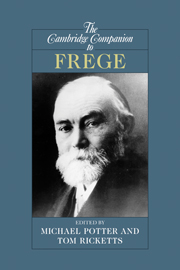Book contents
- Frontmatter
- 1 Introduction
- 2 Understanding Frege’s project
- 3 Frege’s conception of logic
- 4 Dummett’s Frege
- 5 What is a predicate?
- 6 Concepts, objects and the Context Principle
- 7 Sense and reference: the origins and development of the distinction
- 8 On sense and reference: a critical reception
- 9 Frege and semantics
- 10 Frege’s mathematical setting
- 11 Frege and Hilbert
- 12 Frege’s folly: bearerless names and Basic Law V
- 13 Frege and Russell
- 14 Inheriting from Frege: the work of reception, as Wittgenstein did it
- Bibliography
- Index
- Series List
7 - Sense and reference: the origins and development of the distinction
Published online by Cambridge University Press: 28 September 2010
- Frontmatter
- 1 Introduction
- 2 Understanding Frege’s project
- 3 Frege’s conception of logic
- 4 Dummett’s Frege
- 5 What is a predicate?
- 6 Concepts, objects and the Context Principle
- 7 Sense and reference: the origins and development of the distinction
- 8 On sense and reference: a critical reception
- 9 Frege and semantics
- 10 Frege’s mathematical setting
- 11 Frege and Hilbert
- 12 Frege’s folly: bearerless names and Basic Law V
- 13 Frege and Russell
- 14 Inheriting from Frege: the work of reception, as Wittgenstein did it
- Bibliography
- Index
- Series List
Summary
Frege's distinction between sense (Sinn) and reference (Bedeutung) has been his most influential contribution to philosophy, however central it was to his own projects, and however he may have conceived its importance. Philosophers of language influenced by, or reacting against, the distinction and historians of philosophy commenting on it, have all contributed to the voluminous literature surrounding it. Nonetheless in this essay I hope to shed new light on the distinction by considering it in the context of the development of Frege's thought, and connecting it more intimately than is usually done with Frege's interests in logic, especially his views on judgement, truth and inference, which were central to his own projects as he conceived them.
Frege does not employ the terminology of sense and reference in his first great logical-philosophical work, the Begriffsschrift of 1879 (Bs). However, Bs already contains the seeds of the distinction in its notion of 'content' (Inhalt). Tracing out the difficulties inherent in Frege’s early talk of ‘content’ illuminates the need for this distinction, as well as his further difficulties in formulating it. Bs contains two distinct, yet interrelated, ancestors of the sense–reference distinction. Section 1 discusses the first root of the distinction, which lies in Frege’s notion of judgeable content, expressed by sentences. The second root lies in his account of identity sentences, and the associated idea of ‘modes of determination’ of a content. Section 2 explores this account in detail, and reveals some of the difficulties inherent in it. Sections 3 and 4 show how the needs of Frege’s project in the philosophy of mathematics brought these difficulties to the fore and led to the development of the mature sense–reference distinction. Sections 5 to 8 expound Frege’s mature vision; section 9 then examines some of the remaining difficulties in the light of the development of the distinction.
- Type
- Chapter
- Information
- The Cambridge Companion to Frege , pp. 220 - 292Publisher: Cambridge University PressPrint publication year: 2010
- 27
- Cited by



